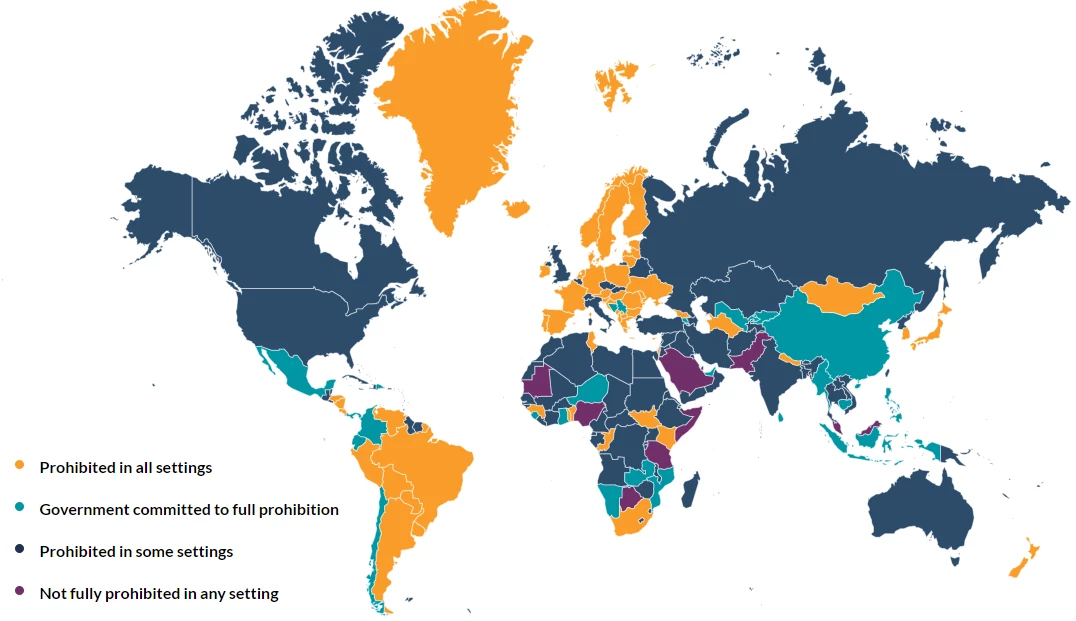 A classroom
A classroom
Corporal punishment is a practice that remains widespread in many schools around the world. And it is unacceptable. We pay a lot of attention to pedagogical interventions, technological innovations, providing devices and many other programs and policies to improve learning. But any educational investment will be irrelevant if a child is not safe at school (and at home). April 30th is the International Day to End Corporal Punishment of Children. Tragically, almost one in three countries (64 out of 199) do not fully prohibit corporal punishment in school. Many of the countries that allow corporal punishment are in Africa, the Middle East, and Asia, and the list also includes some rich countries.
Corporal punishment, as well as a lack of safety in school and violence, including bullying and/or gender-based violence, profoundly affect students’ ability to learn as well as teachers’ ability to teach. Evidence suggests that students exposed to corporal punishment are more likely to adopt negative behaviors and to regress academically in terms of learning compared to peers who were not exposed to those practices.
In Francophone Africa, according to PASEC data, around one-third of teachers (both male and female) in grade 6 reported using corporal punishment in the classroom. On the student-side, almost two-thirds of children/youth reported being beaten by teachers. In addition, a third of students declared being afraid at school, which had a large and statistically significant negative effect on their performance on learning assessments. A study for the Middle East and Northern Africa suggests that unsafe schools with deteriorated classroom disciplinary practices significantly reduces students’ performance.
Moreover, corporal punishment is also a factor which is associated with student-drop out, bullying, and other antisocial behaviors. Corporal punishment can also negatively impact outcomes such as, social and emotional well-being and leave permanent scars that affect productivity later in life.
While teachers are a key contributor to a students’ sense of safety, they are often not provided with the training and resources needed for the extremely complex task of managing and teaching students with varied emotional, social, and pedagogical needs. Faced with such situations, some teachers resort -unjustifiably- to corporal punishment. It is not surprising that among different types of school violence prevention interventions, those focusing on providing teachers with skills to improve their relationships with students and manage students’ behaviors had the strongest and most reliable results in terms of lessening disruptive and aggressive behaviors in the classroom, improving learning outcomes, and enhancing pro-social behaviors later in life.
Providing teachers with tailored, practical, permanent opportunities for professional development that focus on improving their skills in classroom management, positive reinforcement, and teacher-student interaction is key to improving teacher-student interactions and the classroom environment. Through practice and modeling, teachers and students can learn new skills for social interaction, emotional well-being, and learning, so that extreme measures such as corporal punishment or any other form of violent behavior are avoided.
Social and emotional trainings have also been shown to be effective in improving students’ pro-social behaviors and learning outcomes. A meta-analysis of the most effective classroom management interventions to improve students’ academic and social-emotional skills and overall behavior highlights the benefits of such learning programs. Moreover, research shows that experiential learning and collaborative learning techniques also improve students’ achievement, relationships, and self-views. The WHO handbook on school violence prevention provides useful resources on positive discipline for teachers and schools.
It is important to remember that the lives of teachers and students are interconnected. They are part of a school ecosystem that is bound by limited resources, capacity, and institutional arrangements. Contextualization of interventions and critical analysis of the different variables influencing teacher and student behavior is necessary.
One program that has been successful in reducing violence in primary schools including corporal punishment is the Good School Toolkit in Uganda. The program works provides behavioral change techniques. It focuses on goal setting, positive discipline, empathy, and reflection along with practicing new behavioral skills among teachers and school staff. An evaluation suggests that after 18 months of implementation, the toolkit reduced the risk of physical violence by teachers and school staff against students by 42 percent; halved the number of teachers who reported using physical violence against students; and improved students’ feelings of connectedness, their well-being and sense of safety and belonging with their school.
Programs such as this are often considered to be using a ‘whole school’ approach to preventing and reducing violence in school, highlighting the fact that multiple stakeholders have a role to play in violence prevention. The school climate can be transformed when teachers, students, and the school community work together to strengthen respect and trust and when they acknowledge that corporal punishment is not only counterproductive but negatively impacts a child’s learning and well-being.
Promoting safe schools is an integral part of the World Bank’s Approach to improve learning (Pillar 4), which focuses on supporting safe and inclusive schools by ensuring that schools are equipped with the necessary infrastructure, human resources, policies, and norms to enable all children to learn in a welcoming environment, free from discrimination, violence, bullying, and, indeed, corporal punishment. The World Bank and the Global Partnership to End Violence against Children are currently finalizing an “investment case” study for policies and programs to end violence in school which is expected to be published later this year.
The World Bank also supports countries in developing legislation to foster safe and inclusive schools and work on analyzing and modifying their existing legal framework to develop a universal prohibition of corporal punishment. We stand ready to support countries in implementing measures to change pervasive social norms and foster a positive school climate and safe learning, involving children, parents, educators, and communities.
Schools need to be safe, which requires a whole-school and beyond-the-school approach that prevents and addresses violence and abuse. All forms of violence against children, including corporal punishment in school, need to be forbidden to set clear standards for all. But it not mostly about legislation and its enforcement. It is about urgently changing mindsets. Children and youth need to feel respected, valued, safe, and happy in school. That is probably the most important objective of the educational experience. If a child or young person does not feel welcome, have a sense of belonging, and feel happy and safe at an educational institution, not even the right pedagogy, the most advance technology or the best learning spaces will lead to learning. Corporal punishment is unacceptable and intolerable. And is also a major hindrance to learning. A key development challenge is to stop it.








Join the Conversation